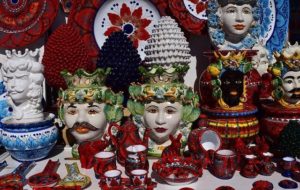Sicily, a magical and colorful land, has been throughout the centuries a crossroads of cultures and religions. Many people have found on this magical island the ideal place to settle there.
One of the icons of this beautiful region is the so-called “Teste di Moro”. This pair of ceramic heads representing a man and a woman are objects that can be seen recurrently along the streets of Sicily.
They are normally hand-painted in bright colors, and they are a frequent object of decoration in Italian houses and gardens.
Thus, these famous “teste di Moro”, also called in the dialect “Graste” are an emblematic symbol of Sicily and provide, in turn, a touch of joy, vivacity, and elegance.
Its unique and original design has inspired artisans and designers around the world for many years. Proof of this is that the famous brand Dolce Gabbana decided to include them in its 2014 collection in various luxury items such as prints and jewelry.
However, these precious decorative objects have their origin in an ancient legend that mixes passion, jealousy, betrayal, and revenge of a couple in love. Today we will tell you about this intriguing story:
THE MORO AND THE FANCIULLA
According to legend, around the year 1110 B.C. in the heart of Palermo lived a girl of incomparable beauty. In addition to her physical attractiveness, she loved taking good care of the plants on her balcony. She spent her days in this garden and many of the passers-by who passed by fell in love with her.
One day a Moor who was in sight of the city passed by the street where the young “fanciula” lived and fell in love with her. The young woman reciprocated his passion. Unfortunately, the foreign man hid that he was married and even had children waiting for him at home in the Far East. The young woman’s heart broke into a thousand pieces when she learned the truth. She was full of anger and hatred. Therefore, she looked for a way to get revenge on her lover.
One night before he returned to his homeland, she asked to be with him one last time. When the young Moor had fallen asleep in her lap, the woman took a dagger and behead him. In this way, he would remain forever by her side. She decided to make a pot to plant a beautiful basil plant, which is incredibly fragrant throughout the whole street. The neighbors, envious of this plant, decided to copy this custom by imitating the facial features of the Moor in this particular terracotta vase.
Currently, these pots are always sold in pairs, one representing the Moor and the other the fanciula.


